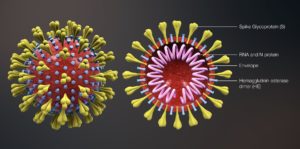This week Chinese scientists refuted the claim that the new novel coronavirus is a type of SARS virus. While coronavirus share some genetic similarities with the SARS virus but it is not a type of SARS. Research shows coronavirus and SARS share about 79% of their genetic sequence, as an example, they both use the same ACE2 receptor to enter cells, they are related but distant organisms.
SARS’s symptoms are more serious, it has a higher mortality rate, 9.6%. Coronaviruses are a large family of RNA viruses and have the high recombination frequency therefore they can mutate and change at a high rate. This makes coronavirus more easily transmissible but less likely to cause severe disease with estimated 2 to 4% mortality rate according to Chinese authorities.

Courtesy of University of Michigan
Coronaviruses are a large family of RNA viruses. They look like halos when viewed under the electron microscope. They are the largest known RNA virus genome and have the highest known frequency of recombination. Coronavirus viruses mutate and change at a high rate.

Wikipedia
It is important for scientists to understand the genetic sequence of the virus in order to determine what proteins it uses, how it replicates and what makes the virus unique. This information can help the scientists to design antiviral solutions and develop animal models. As an example, targeting the ACE2 receptor, researchers from Peking University have selected several candidates for treating the novel coronavirus (COVID-19) by screening 2,674 medicines in the market and 1,500 herbal extracts.
It’s understandable that the rapid dissemination of information may be overwhelming. It is important to be informed by credible sources such as CDC while eliminating sensational misinformation that creates unwarranted panic.
Fitgenetix is proud of its large Chinese customer base. We are curating and publishing up-to-date information from credible sources about coronavirus in English and in Mandarin. If you have specific questions, please contact support@fitgenetix.com.
Stay tuned for further updates!


